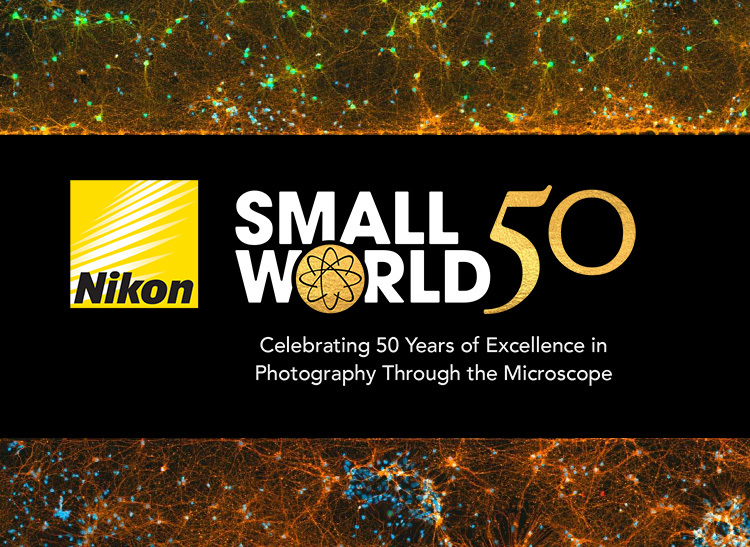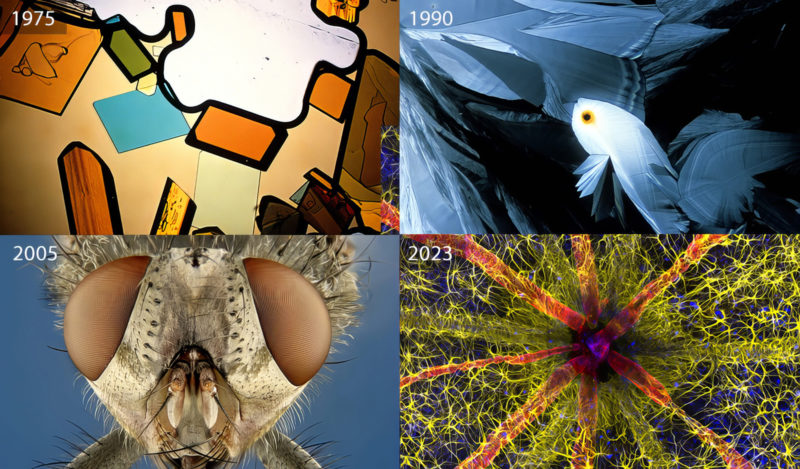From its humble origins to the forefront of cutting-edge innovations in microscopy, Nikon Small World has not only showcased the marvels of the unseen but has also charted the evolution of imaging techniques, technologies, and creativity in scientific imaging. This year marks the competition’s 50th anniversary, a true celebration of art and science, and the individuals behind the lens that have shed light on the breathtaking beauty of the microscopic world.
Nikon Small World Celebrates Fifty Years of Microscopic Marvels

Posted on April 20, 2024
Origins and Modest Beginnings
In 1974, Nikon launched the Small World Photomicrography Competition with a simple yet bold mission: to showcase the beauty and complexity of things seen through the light microscope. What started as a modest contest with the goal of recognizing excellence in photomicrography grew into a global phenomenon, captivating scientists, artists, and enthusiasts alike.
The first images were released in 1975, attracting entries from a diverse range of fields, including photography, biology, chemistry, and metrology, to name a few. With each passing year, the competition grew until it became the leading forum for artistic expression through microscopic imagery. As the technology evolved, it encouraged the creation of its sister competition, Small World in Motion. Established in 2011, Small World in Motion recognizes proficiency and excellence in videos taken under the microscope.

As microscope and photography equipment have gotten more sophisticated over the years, so have the winning Nikon Small World images.
Evolution of Imaging Techniques
Over the past five decades, Nikon Small World has not only witnessed incredible advancements in microscopy, and of course digital imaging technologies, but also been at the forefront of driving innovation in imaging techniques. The digital imaging movement has helped to spawn groundbreaking technologies in microscopy, from traditional light microscopy image capture to technologies such as confocal and super-resolution microscopy. The Nikon Small World competition has embraced these advancements and has helped showcase what is possible in the realm of microscopy.
"As Nikon Small World enters its sixth decade, the future looks brighter than ever,” said Steve Ross, Director of Product and Marketing at Nikon Instruments. “With advances in technology driving innovation at an unprecedented pace, the possibilities for imaging are endless. I look toward the future of the competition with eager anticipation for the next wave of discoveries and the profound impact they will have on science, art, and our understanding of the world around us."
A movie taken with a confocal microscope depicting lateral line cells and melanocytes migrating in a zebrafish embryo won first place in the 2022 Small World in Motion video competition.
A Showcase of Diversity and Beauty
From the intricate patterns of a butterfly wing to the delicate structure of a diatom, every image and video submitted to the competition tells a unique story of scientific discovery, artistic creativity, and awe-inspiring wonder. Achieving a compelling submission requires a blend of technical mastery and creativity, coupled with a deep understanding of composition, lighting, and subject matter.
“As we commemorate 50 years of Nikon Small World, we’re not just celebrating microscopic imagery; we’re celebrating the relentless pursuit of innovation and the boundless creativity that fuels it,” said Eric Flem, Senior Manager, CRM and Communications at Nikon Instruments. “Each entry in this competition is a testament to the profound beauty and diversity found in the microscopic world.”

Looking to the Future
Nikon Small World continues to inspire, educate, and captivate audiences around the globe. As we look back on its remarkable legacy, we are reminded that there is a story to be told in even the smallest of details. Here's to the next 50 years of microscopic marvels and the endless beauty that lies waiting to be discovered.
The deadline for both the 2024 Nikon Small World Photomicrography and Small World in Motion competitions is coming up on April 30th for scientists and photomicrographers to submit their images and videos taken through the microscope.
Contestants may submit up to three images or movies digitally at the Nikon Small World Entry Portal. Entries will be judged by industry experts on a variety of criteria such as originality, technical proficiency, and visual impact. Entrants may use any brand of equipment to create their images or videos.
